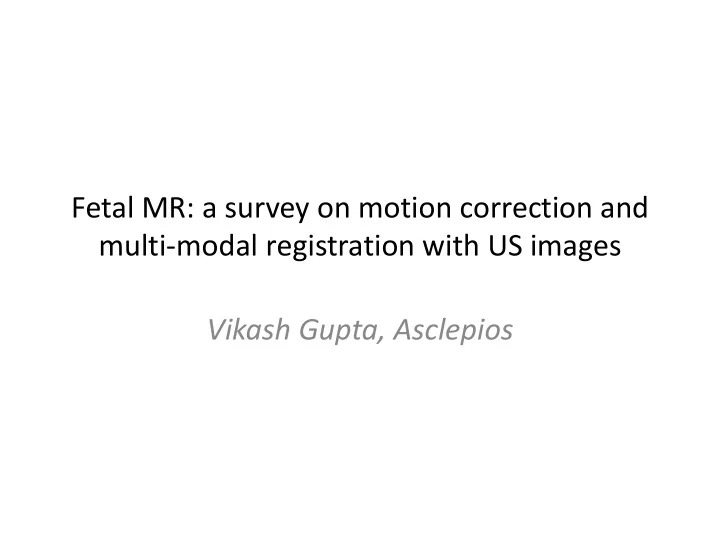

Fetal MR: a survey on motion correction and multi-modal registration with US images Vikash Gupta, Asclepios
MRI: First words MRI System T1 weighted T2 weighted Fiber tracts • Other names nuclear magnetic resonance( NMR), nuclear magnetic tomography (NRT). • Non-invasive imaging modality • Use strong magnetic fields to form images of the body • Widely used for medical diagnosis.
Ultrasound Images US setup US of a fetus US of a fetal brain • Portable and affordable • Used for visualizing blood vessels, muscles, tendons etc. • Low resolution images. • Limited field of view (FOV) • Limited by medical expertise.
Motion artifacts in fetal imaging Range of motion of a fetus (star represents the head dotted lines represent the legs) Breathing Artifacts
Causes of motion artifacts • Macroscopic motions • Patient movement. • Movement of the fetus (unsettled neonate). • Microscopic motions • Physiologic motions (respiratory motions, blood flow) – Unpredictable motion • Yawning, provoked motion due to the scanner Rigid body motion
Preventing motion artifacts • Possible to minimize the artifacts – Breath holding and using fast imaging sequences – Cardiac gating – Imaging the fetal in the supine state or sedation. – Motion resistant sequences PROPELLER,
Multimodal Registration: US and MRI • Why ? – MRI is used to confirm any fetal abnormality detected with US. – MRI doesn’t suffer from acoustic shadows caused by the skull. – Possibility of a better diagnosis. • Challenges – Intensity difference between the two modalities – Changes in FOV – Choice of similarity measure
Proposed method • Reconstruct high resolution fetal MRI • Segment the brain structures using an EM algorithm • Segmentation of the non-brain structures • Generating a pseudo US image. • Register the pseudo US image with the 3D US image.
Workflow
Reconstruction of the fetal MRI • A super-resolution reconstruction method is employed • Similarity measure is normalized mutual information (Studholme et. al 2011) • Edge preserving regularization
Segmentation of brain structures • Segmentation using EM algorithm in combination with a probabilistic atlas.
Generating a Pseudo US Image • US images are created by reflections of tissue boundaries and speckle patterns produced by interference. • Speckle patterns are hard to model so are neglected. • A speckle free pseudo US image is generated. • The pseudo US image is registered to a smoothed US image using Gaussian blurring. • The order of intensity in different tissue structures is fixed, though there is a spatial variation. • Local normalized cross-correlation is used as a similarity measure for registering the pseudo US to the real US image.
Alignment of MR and US images • Pseudo US image represents the ideal artifact free US image. • The MR and the pseudo US image are registered. • A robust block matching algorithm (Ourselin et al., 2001 ) is used for registration. – NCC is used to identify the most similar blocks between the source and target images. – The set of vectors defined by the centroids of pairs of images forms a displacement field which is regularized. – A rigid/affine transformation is estimated from the displacement field using least trimmed squared (LTS) regression (Rousseeuw, 1984).
Results MR Images US Images Overlapped MR and US Images
Aligned average MR and US Images Average of 27 fetal brain with gestational age 18-22 weeks aligned with MRI (GA 23 weeks)
Conclusions • Useful for generation a template US image of the fetal brain. • Population based longitudinal studies for neonatal development. • Alignment of new acquired images to the template space for better diagnosis and comparision. • A spatio-temporal template based growth study. • Useful for discovering new biomarkers for abnormal growth.
Recommend
More recommend